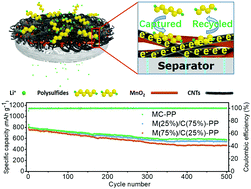Inhibiting polysulfide shuttling using dual-functional nanowire/nanotube modified layers for highly stable lithium–sulfur batteries†
Abstract
The shuttle effect of dissolvable polysulfides (PSs) severely deteriorates the cycling performances of lithium–sulfur (Li–S) batteries and consequently hampers their practical application. To inhibit the PS shuttle effect, here we designed a modified separator by directly coating a thin layer of ultralong one-dimensional MnO2 nanowires (NWs) interlaced with carbon nanotubes (CNTs) on a commercial polypropylene (PP) separator. Such a MnO2/CNT modified layer exhibits dual functions to effectively trap and reutilize the dissolved PSs, where the MnO2 NWs allow the chemical adsorption of the PSs while the CNTs form a conductive network for electron transfer to accelerate the PS redox reaction. Meanwhile, the migration of lithium ions will not be influenced due to the porous structure formed by these NWs and nanotubes. This MnO2/CNT/PP separator can significantly inhibit PS shuttling in comparison with neat MnO2 NW or CNT modified separators. Using the optimal separator, we demonstrate a highly stable Li–S battery with an initial capacity of 843.7 mA h g−1 at 1C, and a capacity retention of 68.03% over 500 cycles. This study shows a comprehensive design strategy for a modified separator to inhibit the PS shuttle effect for highly stable Li–S batteries.



 Please wait while we load your content...
Please wait while we load your content...